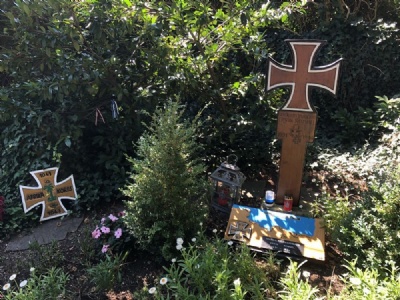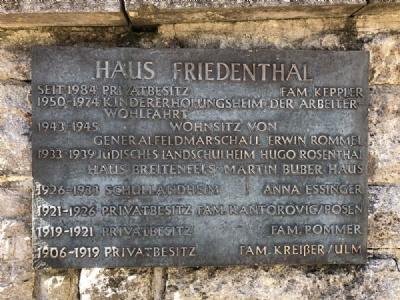Herrlingen
In Herrlingen, just west of Ulm in the state of Baden-Württemberg, Field marshal Erwin Rommel is laid to rest. Rommel was born in November 1891 in Heidenheim and as early as 1910 he enrolled as an officer cadet at the Württemberg infantry regiment. In the First World War he served as a lieutenant in France, Romania and Italy. After the war, he continued to serve in the German armed forces (Reichswehr), although it had been hugely reduced as a consequence of the Versailles treaty. After Hitler came to power in January 1933, he began as an instructor at various military academies. In 1937 he wrote a book about his experiences from the First World War and in 1938 he became commander of the officer school in Wiener Neustadt in Hitler-occupied Austria.
At the beginning of the Second World War he became the commander of the force guarding Hitler’s headquarters (not a personal bodyguard) and thus came to know Hitler. In the spring of 1940 he was appointed commander of the seventh armoured division. His boldness and skill in harnessing motorized and mechanized units reaped great military success on the Western front in the spring of 1940. His victories attracted a great deal of attention and respect, not least from Hitler. But more experienced and older generals were not as fond and impressed by this newcomer.
In February 1941, Rommel was appointed commander of the German forces sent to North africa to help the italian army. Italy had invaded Egypt in September 1940 as part of Mussolini’s vision of a new domination of the Mediterranean. High Italian military commanders, however, were sceptical about this and warned Mussolini that Italy was not prepared and that the British forces should not be underestimated. The Italian forces were also scattered across North Africa and were soon faced with an inevitable defeat.
Hitler therefore decided to help his ally by sending Rommel and his African corps. Rommel immediately reaped military success and drove the British forces eastward. Rommel was nicknamed the Desert Fox and became a respected commander of his opponents. Rommel also became a hero within Germany where not only Hitler, but also Goebbels, saw the value in highlighting Rommel as a true war hero.
German success in North Africa came to an end at El alamein in 1942 when the British eighth army halted the german advance. Rommel subsequently failed to reclaim the military initiative in North africa and in may 1943 the German forces were evacuated. Faced with the approaching defeat, Hitler had called home Rommel already in March. For Hitler, the North african front became secondary. Rommel constantly complained that he did not have enough supplies to carry out his military operations. Rommel was also accused of not considering that supplies couldn’t keep up with the same speed as his army advanced. This inevitable led to stretched out supply lines and a halt of his army.
Rommel then kept a fairly low profile before he in 1944 became responsible for the coastal defence of the French north coast. Hitler knew that the western allies were planning an invasion of the French mainland, and from a moral point of view, the war hero, the desert fox, Rommel was best suited for this. Rommel’s tactic was that the enemy must be stopped at all costs at the shores and not allowed to gain a foothold. Rommel considered that the defensive positions were far from adequate and required more material and labor to expand them.
When the invasion took place in the morning hours of June 6, 1944, Rommel was with his family in Herrlingen. He immediately returned to Normandy only to find that the enemy had succeeded in gaining a foothold and was soon able to establish bridgeheads. Rommel then realized that the war could not be won, and felt that one should investigate the possibilities for a peace, at least with western allies. For Hitler, this was unthinkable, but other forces in the military took matters into their own hands. The soldiers who conspired against Hitler and wanted to remove him tried to convince Rommel to join the conspirators, but failed. When the attempt on Hitler’s life took place on 20 July 1944 at his headquarters in East Prussia, Rommel was hospitalized for injuries he had suffered in France, early July, when his car was attacked by an enemy plane.
Although Rommel did not actively participate in the planning and the attempt of Hitler’s life, he knew about it and could therefore not be considered innocent. He was faced with an ultimatum to commit suicide with full military honors and a state funeral and the promise that his family would not suffer. If not, he would be dishonored and his family inevitably suffer. That he had the opportunity to choose should be seen in the light of the fact that he was still a war hero and a icon in Germany.
On October 14, 1944, Rommel bid farewell to his family in the villa in Herrlingen. He was taken by car to a place just outside Herrlingen where he committed suicide by taking poison. On October 18, he received a state funeral in Ulm and was buried in the cemetery in Herrlingen.
Current status: Preserved with monument (2020).
Location: 48°25' 15.56" N 09°53' 51.55" E
Get there: Car.
Follow up in books: Fraser, David: Knight’s Cross: A Life of Field Marshal Erwin Rommel (1994).








Rommel, and his Africa Corps, became a legend in his own lifetime and that legend has survived to our days. This, if anything, is proof that the Nazi propaganda survived its own defeat. The generally accepted conception of Rommel is very much the same as was prevailing in his own lifetime. In a way, he still stands today (2020) above all forms of critical examination that his contemporary colleagues in the German army did not escape. Although Rommel’s name cannot be linked to any direct war crimes and that he eventually became hesitant to Hitler, he never came to support the conspirators. That Rommel was a man to take over after Hitler if he had died is doubtful. Older and more conservative generals and field marshals were suspicious of Rommel whom they felt had undeservedly been put on the pedestal.
In Herrlingen there is a large monument on the site where he committed suicide and it is even signposted. The grave at the cemetery where he is buried together with his wife Lucille is well-groomed and I guess it is visited often by both curious and those who want to praise him as one of the greatest, if not the greatest, general of them all. In the villa Lindenhof near the cemetery there is a small museum dedicated to Rommel (not sure if it is still open). Haus Friedenstahl where Rommel lived with his family was in private ownership in 2020 but there is a small information board on the wall with the names of the families who lived in the villa.